- Growing Sweet Peppers in the Ground: Secrets to Success
- 1. Choose the Right Location
- 2. Prepare the Soil
- 3. Start Seeds Indoors
- 4. Transplanting Seedlings
- 5. Provide Adequate Support
- 6. Water Regularly
- 7. Fertilize Appropriately
- 8. Manage Pests and Diseases
- 9. Harvest at the Right Time
- 10. Store and Enjoy!
- Choose the Right Pepper Varieties
- Prepare the Soil for Optimal Growth
- 1. Test the Soil
- 2. Clear the Area
- 3. Amend the Soil
- 4. Apply Fertilizer
- 5. Mulch the Soil
- 6. Water the Soil
- Planting and Spacing
- Choosing the right location
- Spacing
- Planting
- Watering and Fertilizing for Fast Growth
- Watering
- Fertilizing
- Protecting Your Plants from Pests and Diseases
- 1. Identify Common Pests and Diseases
- 2. Practice Crop Rotation
- 3. Use Natural Pest Control Methods
- 4. Maintain Proper Hygiene
- 5. Water Plants Properly
- 6. Apply Organic Pest and Disease Controls
- 7. Monitor Your Plants Regularly
- 8. Use Companion Planting
- 9. Consider Using Protective Covers
- 10. Read and Follow Product Instructions
- Pruning and Supporting Pepper Plants
- Pruning Pepper Plants
- Supporting Pepper Plants
- Additional Tips
- Harvesting Your Bountiful Pepper Crop
- 1. Timing is key
- 2. How to pick peppers
- 3. Harvesting techniques
- 4. Handling peppers properly
- 5. Storing your harvest
- 6. Using your peppers
- Troubleshooting Common Pepper Growing Problems
- 1. Pest Problems
- 2. Disease Issues
- 3. Nutritional Deficiencies
- 4. Environmental Stress
- “Question-Answer”
- What is the best soil for growing sweet peppers?
- How often should I water sweet pepper plants?
- Can sweet peppers be grown in containers?
- What is the best way to fertilize sweet pepper plants?
- How can I protect sweet pepper plants from pests?
- Do sweet peppers require a lot of sunlight?
- How do I know when sweet peppers are ready to harvest?
- “Video” How to Grow Bell Peppers from Seed in Containers | Easy planting guide
Growing your own sweet peppers can be a rewarding and delicious experience. However, it can also be a bit tricky if you don’t know the secrets to success. In this article, we will share expert tips that will help you grow sweet peppers in the ground and achieve a bountiful harvest.
Choose the right location: Sweet peppers love warm weather and require at least 6-8 hours of direct sunlight each day. Choose a location in your garden that receives ample sunlight and is sheltered from strong winds.
Prepare the soil: Sweet peppers thrive in well-draining soil that is rich in organic matter. Before planting, amend the soil with compost or well-rotted manure to improve its fertility and drainage.
Water consistently: Sweet peppers need consistent moisture to grow properly. Water your plants regularly, especially during dry periods, but be careful not to overwater as this can lead to root rot. Mulching around the plants can help retain soil moisture.
Provide support: As sweet peppers grow, they can become top-heavy and may require support. Stake or cage your plants to prevent them from sprawling on the ground and to aid in air circulation, which can help prevent diseases.
Fertilize appropriately: Sweet peppers are heavy feeders and benefit from regular fertilization. Use a balanced fertilizer, rich in nitrogen, phosphorus, and potassium, and apply it according to the manufacturer’s instructions. This will ensure fast growth and abundant fruiting.
Incorporate these expert tips into your sweet pepper growing routine, and you’ll be rewarded with a bountiful harvest of delicious, homegrown peppers. Happy gardening!
Growing Sweet Peppers in the Ground: Secrets to Success
1. Choose the Right Location
When selecting a location for growing sweet peppers in the ground, it’s important to choose a spot that receives full sun for at least 6-8 hours a day. Peppers thrive in warm temperatures, so try to find a location that is protected from strong winds.
2. Prepare the Soil
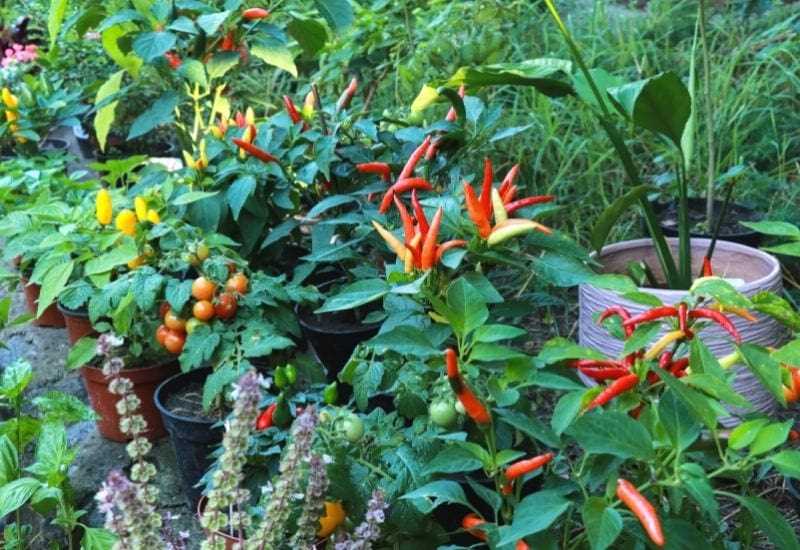
Before planting sweet peppers, prepare the soil by loosening it with a garden hoe or tiller. Remove any weeds or rocks, and add organic matter such as compost or well-rotted manure to improve the soil’s fertility and drainage.
3. Start Seeds Indoors
For an early start, it’s recommended to start sweet pepper seeds indoors 6-8 weeks before the last frost date. Use seedling trays or small pots filled with a high-quality potting mix. Keep the soil moist and provide sufficient light for the seeds to germinate.
4. Transplanting Seedlings
When the seedlings have reached a height of 4-6 inches and the danger of frost has passed, they are ready to be transplanted into the ground. Choose a calm, overcast day or transplant in the late afternoon to minimize stress on the plants.
5. Provide Adequate Support
As sweet pepper plants grow, they may become heavy with fruit and require support to prevent the branches from breaking. Use stakes or tomato cages to provide support and keep the plants upright.
6. Water Regularly
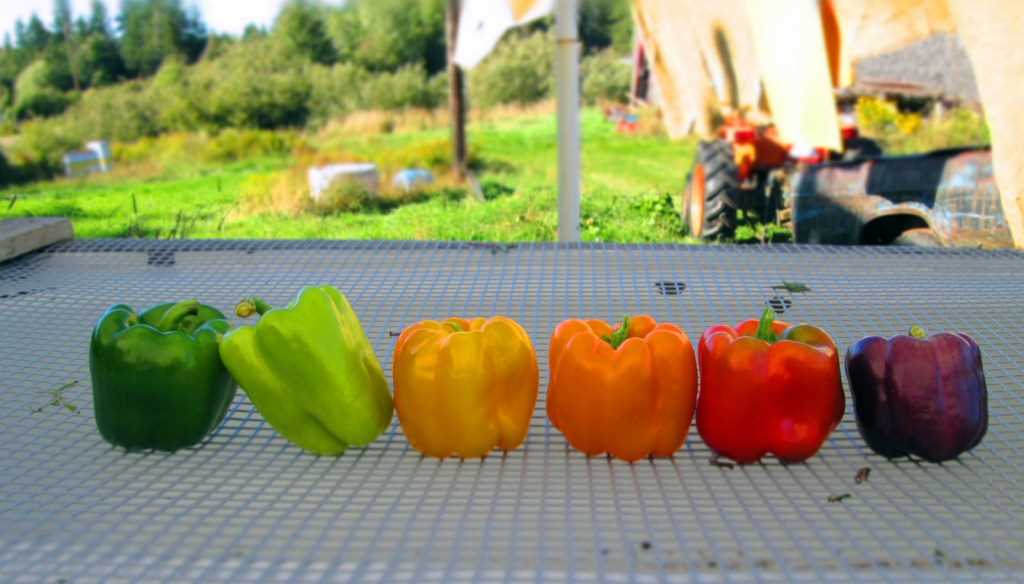
Keep the soil consistently moist, but not waterlogged. Water the plants deeply once or twice a week, providing approximately 1-2 inches of water per week. Watering in the early morning or late afternoon is best to avoid evaporation.
7. Fertilize Appropriately
Apply a balanced fertilizer, such as a 10-10-10 blend, once a month during the growing season to provide the sweet pepper plants with essential nutrients. Follow the instructions on the fertilizer package for the recommended application rates.
8. Manage Pests and Diseases
Monitor your sweet pepper plants regularly for common pests such as aphids, spider mites, and caterpillars. Use organic pest control methods whenever possible to avoid the use of harmful chemicals. Also, keep an eye out for signs of disease, such as leaf spots or wilting, and take appropriate action to prevent the spread.
9. Harvest at the Right Time
Sweet peppers can be harvested when they reach their full size and color. Typically, this occurs around 60-90 days after transplanting. Use a sharp pair of scissors or pruning shears to cut the peppers from the plant, leaving a short stem attached.
10. Store and Enjoy!
Store harvested sweet peppers in a cool, dry place for up to a week. If you have an abundant harvest, consider preserving them by freezing, canning, or pickling. Enjoy your homegrown sweet peppers in a variety of dishes, from salads to stir-fries!
Choose the Right Pepper Varieties
- When it comes to growing sweet peppers in the ground, choosing the right pepper varieties is crucial for a successful harvest. Different varieties have different growth habits, fruit sizes, and flavors, so it’s important to select the ones that best suit your preferences and gardening conditions.
- There are many sweet pepper varieties to choose from, including bell peppers, banana peppers, cubanelle peppers, and cherry peppers. Each type has its own unique characteristics and is suited for different uses, such as stuffing, stir-frying, or eating fresh.
- Consider factors such as the length of your growing season and the climate in your area when selecting pepper varieties. Some varieties are better suited for shorter growing seasons or cooler climates, while others thrive in longer growing seasons or warmer climates.
- Pay attention to the heat level of the pepper varieties you choose. Sweet peppers generally have a mild flavor, but some varieties may have a slightly spicy kick. If you prefer milder peppers, look for varieties labeled as “sweet” or “mild.”
- Another important consideration is the size of the fruit. Some pepper varieties produce large, blocky fruits, while others produce smaller, elongated fruits. Choose the size that suits your intended use and garden space.
- It’s also worth considering disease and pest resistance when selecting pepper varieties. Look for varieties that are known to be resistant to common pepper diseases, such as bacterial spot or tobacco mosaic virus. This can help ensure a healthier and more productive pepper crop.
- Ultimately, the right pepper varieties for you will depend on your personal preferences, growing conditions, and intended use. Do some research, ask local gardeners or experts for recommendations, and experiment with different varieties to find the ones that work best for you.
Prepare the Soil for Optimal Growth
Before planting sweet peppers in the ground, it is crucial to properly prepare the soil to ensure optimal growth and a bountiful harvest. Here are some steps to follow:
1. Test the Soil
Start by testing the soil pH and nutrient levels. Sweet peppers thrive best in slightly acidic soil with a pH level between 6.0 and 6.8. Use a soil testing kit available at gardening centers or send a sample to a local agricultural extension service for analysis. Based on the test results, you can adjust the soil pH and add necessary nutrients.
2. Clear the Area
Remove any weeds, rocks, or debris from the planting area. The presence of weeds can compete for nutrients and hinder the growth of sweet peppers. It is also important to ensure good drainage for the plants.
3. Amend the Soil
Add organic matter to the soil to improve its fertility and structure. This can include compost, well-rotted manure, or peat moss. Organic matter helps retain water and nutrients, enhances aeration, and promotes beneficial microbial activity. Work the organic matter into the top 6-8 inches of soil using a garden fork or tiller.
4. Apply Fertilizer
Sweet peppers are heavy feeders, so it is essential to provide them with adequate nutrients. Use a balanced slow-release fertilizer or a granular organic fertilizer. Follow the package instructions for the appropriate amount and evenly distribute it over the planting area. Mix the fertilizer into the soil before planting.
5. Mulch the Soil
Apply a layer of organic mulch, such as straw or wood chips, around the base of the sweet pepper plants. Mulch helps regulate soil temperature, conserves moisture, suppresses weed growth, and prevents soil erosion. Leave a gap around the stem of the plants to avoid rot.
6. Water the Soil
Before planting the sweet pepper seedlings, thoroughly water the soil to ensure it is moist. After planting, water regularly to keep the soil evenly moist, but not waterlogged. Deep watering encourages the plant roots to grow deeper, improving overall plant health.
By following these steps to prepare the soil, you will provide your sweet pepper plants with the ideal conditions for robust growth and a plentiful harvest.
Planting and Spacing
Planting sweet peppers in the ground is an essential part of ensuring a successful harvest. Here are some expert tips on how to properly plant and space your sweet pepper plants:
Choosing the right location
- Select a location that receives full sun for at least 6-8 hours a day. Sweet peppers thrive in warm and sunny conditions.
- The soil should be well-drained and rich in organic matter. Amend the soil with compost or aged manure before planting.
- Avoid planting sweet peppers in areas where tomatoes, peppers, or eggplants were grown the previous year to prevent diseases.
Spacing
- When planting sweet peppers, space the plants about 18-24 inches apart in rows that are about 24-36 inches apart.
- This spacing will allow enough room for the plants to grow and for good air circulation, reducing the risk of diseases.
- If you are planting multiple rows, maintain a distance of at least 36 inches between each row to ensure easy access for maintenance and harvesting.
- Consider using a plant marker or stake to label each plant and row to make it easier for you to keep track of different pepper varieties.
Planting
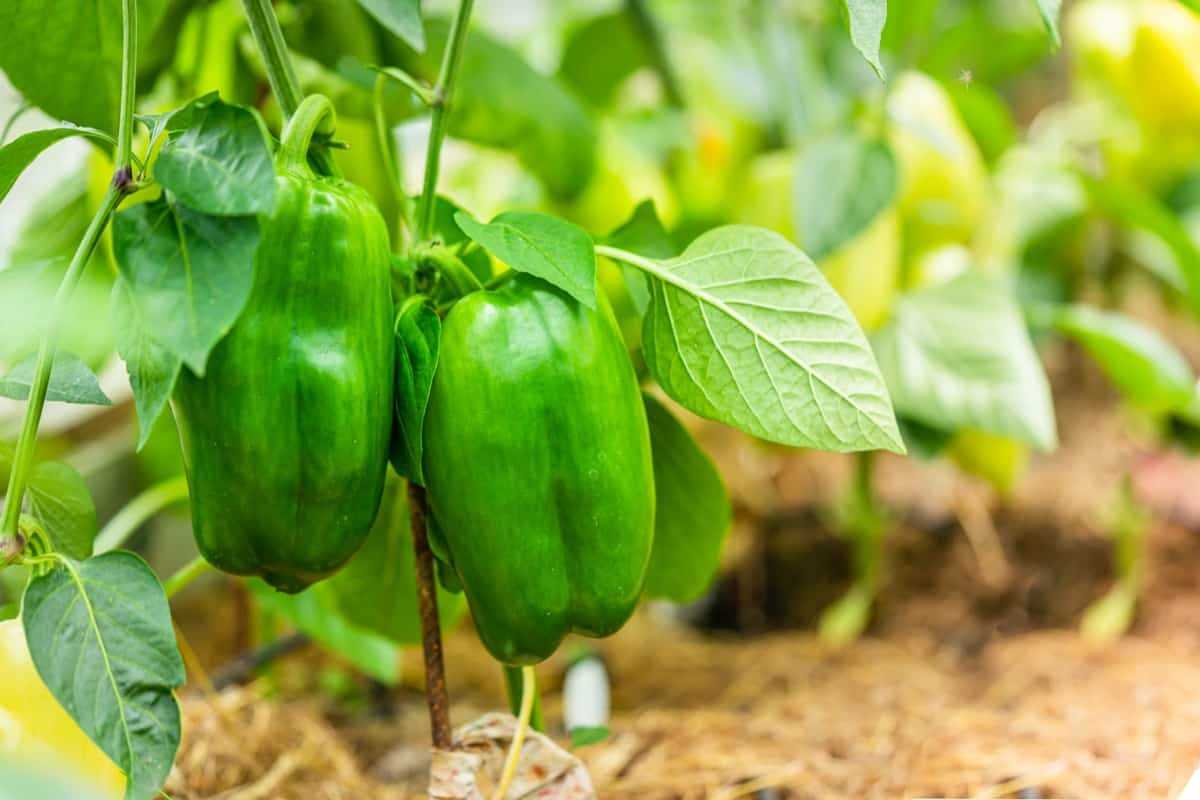
- Before planting, soak the sweet pepper seedlings in water for about 10-15 minutes to ensure they are well-hydrated.
- Dig a hole that is slightly larger than the root ball of the seedling. Gently place the seedling in the hole and fill it with soil, firming it lightly around the base of the plant.
- Water the newly planted seedlings thoroughly to help them establish in the soil.
- You can also consider adding a layer of mulch around the base of the plants to conserve moisture and suppress weed growth.
By following these planting and spacing recommendations, you’ll be well on your way to a successful sweet pepper harvest. Remember to provide regular water, fertilize appropriately, and monitor for pests and diseases to ensure healthy and productive plants.
Watering and Fertilizing for Fast Growth
Proper watering and fertilizing are key to achieving fast growth and abundant fruiting in sweet peppers. Follow these expert tips to ensure your pepper plants receive the right amount of water and nutrients:
Watering
- Water your sweet pepper plants deeply and regularly, especially during periods of dry weather. Aim to keep the soil consistently moist but not waterlogged.
- Provide enough water for the roots to reach deep into the soil, encouraging strong and healthy growth. This will also help the plants withstand hot weather.
- Avoid overhead watering, as it can lead to the spread of disease. Instead, water at the base of the plants or use drip irrigation for more targeted watering.
- Consider mulching around your sweet pepper plants to help retain soil moisture and prevent weed growth.
Fertilizing
- Before planting, amend the soil with well-rotted compost or organic matter to provide a nutrient-rich environment for your sweet pepper plants.
- Once your pepper plants begin to flower, apply a balanced fertilizer with an NPK ratio of around 10-10-10 to promote healthy growth and fruit development.
- Follow fertilizer instructions carefully, as over-fertilizing can lead to excessive foliage growth at the expense of fruit production.
- Consider supplementing with a high-phosphorus fertilizer when your sweet pepper plants start to set fruit. Phosphorus promotes flower set and fruit development.
- Apply fertilizer evenly around the base of the plants, being careful not to let it come into direct contact with the stems or leaves.
By providing adequate water and proper nutrients, you can maximize the growth and productivity of your sweet pepper plants, ensuring a bountiful harvest of delicious peppers.
Protecting Your Plants from Pests and Diseases
1. Identify Common Pests and Diseases
Before you can effectively protect your sweet pepper plants, it’s important to be able to recognize common pests and diseases. Some common pests that may affect your plants include aphids, spider mites, and whiteflies. Diseases such as blight, powdery mildew, and bacterial spot can also pose a threat.
2. Practice Crop Rotation
Crop rotation is a technique where you plant different types of crops in the same area from year to year. This can help reduce the occurrence of pests and diseases that target specific plants. Avoid planting sweet peppers in the same spot for consecutive years to break the life cycle of pests and diseases.
3. Use Natural Pest Control Methods
Consider using natural pest control methods to protect your plants. Some options include introducing beneficial insects like ladybugs that feed on aphids, using insecticidal soaps or neem oil to control pests, and setting up physical barriers like row covers to keep pests away.
4. Maintain Proper Hygiene
Good garden hygiene is essential for preventing the spread of pests and diseases. Remove any dead or infected plant material promptly, as they can serve as breeding grounds for pests and diseases. Clean your gardening tools regularly to avoid spreading pathogens.
5. Water Plants Properly
Water your sweet pepper plants properly to prevent diseases such as powdery mildew. Avoid overhead watering and instead, water at the base of the plants. Ensure proper drainage to prevent waterlogged soil, which can create favorable conditions for diseases.
6. Apply Organic Pest and Disease Controls
Consider using organic pest and disease controls such as organic insecticides and fungicides. These products are typically made from natural ingredients and are safer for both your plants and the environment.
7. Monitor Your Plants Regularly
Regularly inspect your sweet pepper plants for any signs of pests or diseases. Catching problems early can help prevent them from spreading and damaging your entire crop. Look for yellowing leaves, chewed foliage, or any other signs of damage.
8. Use Companion Planting
Companion planting is the practice of planting different plants together to enhance growth and deter pests. Some common companion plants for sweet peppers include basil, marigolds, and onions. These plants can help repel pests and attract beneficial insects.
9. Consider Using Protective Covers
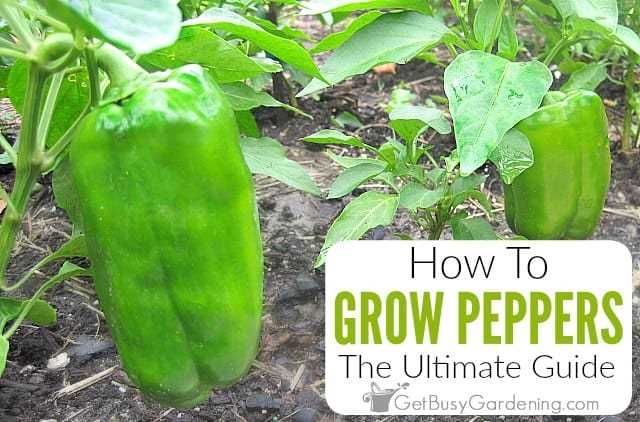
If you’re growing sweet peppers in an area with a high pest population, you may want to consider using protective covers such as netting or screens. These covers can help physically block pests from reaching your plants.
10. Read and Follow Product Instructions
If you decide to use any pest or disease control products, make sure to read and follow the instructions carefully. Proper application and dosage are crucial for the effectiveness of the products and the safety of your plants.
By implementing these tips, you can protect your sweet pepper plants from pests and diseases, ensuring a healthy and bountiful harvest.
Pruning and Supporting Pepper Plants
Pruning and supporting pepper plants are important steps in ensuring healthy growth and maximum fruit production. Here are some expert tips on how to effectively prune and support your pepper plants:
Pruning Pepper Plants
1. Prune the top of the pepper plant when it reaches about 6-8 inches in height. This will encourage lateral branching and help the plant become bushier.
2. Remove any suckers or small branches that grow between the main stem and the branches. These suckers divert energy from fruit production.
3. Trim off any damaged or diseased leaves and branches regularly to prevent the spread of diseases.
4. As the plant grows, continue pruning to improve air circulation and light penetration in the canopy. This will help prevent diseases and increase fruiting.
Supporting Pepper Plants
1. Use stakes or cages to support pepper plants as they grow taller. This helps prevent the plants from bending or breaking under the weight of the fruit.
2. Place the stakes or cages in the ground early in the season before the plant’s roots get too established.
3. Gently tie the main stem of the pepper plant to the stake or cage using soft plant ties. Avoid using materials that can damage or restrict the growth of the plant.
4. As the plant grows, continue to tie the main stem to the support structure at regular intervals to provide additional support.
Additional Tips
1. Prune and support your pepper plants early in the season to ensure that they grow in the desired shape and form. This will also minimize stress on the plant later on.
2. Regularly check your plants for any signs of pests or diseases. Promptly remove any affected parts to prevent further damage.
3. Water your pepper plants adequately, ensuring that the soil is consistently moist but not waterlogged. Proper watering will help the plant recover faster from pruning and support stress.
4. Consider using organic fertilizers or compost to provide the necessary nutrients for healthy growth and fruit production.
By following these tips, you can effectively prune and support your pepper plants, resulting in strong and productive plants that will yield bountiful harvests of sweet peppers.
Harvesting Your Bountiful Pepper Crop
1. Timing is key
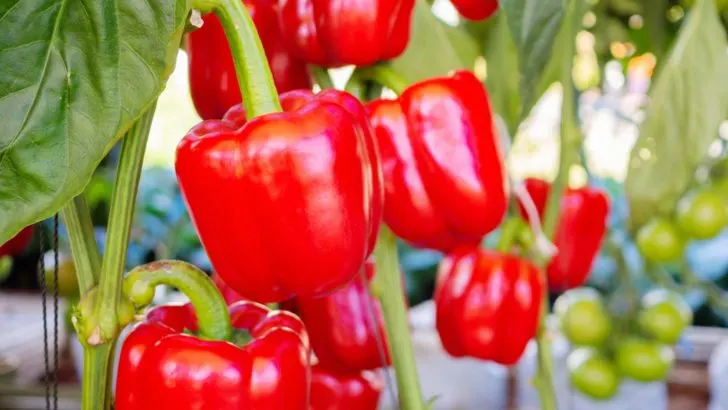
When it comes to harvesting sweet peppers, timing is crucial. The peppers should be fully ripe but not overripe. Generally, sweet peppers are ready to be harvested when they have reached their full size and have turned their mature color. This can vary depending on the variety, so it’s important to keep an eye on your plants and observe the changes in color.
2. How to pick peppers
To harvest your sweet peppers, gently hold the stem of the pepper and carefully twist it until it breaks off from the plant. Avoid pulling or yanking on the pepper, as this can damage the plant. Use a pair of garden shears if the pepper is stubborn or hard to remove.
3. Harvesting techniques
If you have a large pepper harvest, it’s best to use a harvesting technique that minimizes damage to the plants. One effective method is to use a pair of scissors or garden shears to cut the pepper stems about an inch above the fruit. This ensures that you don’t harm the plant and allows for easy collection.
4. Handling peppers properly
Peppers can be delicate, so it’s important to handle them with care after harvest. Avoid squeezing or dropping them, as this can cause bruising or damage. Instead, gently place them in a shallow container or basket to avoid any unnecessary pressure on the fruits.
5. Storing your harvest
If you are not planning to use your peppers immediately, it’s best to store them in a cool, dry place away from direct sunlight. They can be kept at room temperature for a few days, but will last much longer if stored in a refrigerator. To maximize their shelf life, place the peppers in a plastic bag with a paper towel to absorb any excess moisture.
6. Using your peppers
Now that you have a bountiful harvest of sweet peppers, it’s time to enjoy the fruits of your labor! Sweet peppers can be used in a variety of dishes, from salads and stir-fries to stuffing and grilling. Get creative in the kitchen and explore different recipes to fully savor the flavor of your homegrown peppers.
Troubleshooting Common Pepper Growing Problems
1. Pest Problems
Pepper plants can be susceptible to a variety of pests that can damage or destroy your crop. Some common pests that affect peppers include:
- Aphids: tiny insects that suck the sap from plants
- Spider mites: small arachnids that feed on the undersides of leaves
- Thrips: small insects that can cause deformed or discolored fruit
- Pepper weevils: beetles that lay their eggs in pepper buds, causing stunted growth
To prevent and control pests, you can try the following:
- Apply insecticidal soap or neem oil to control aphids and spider mites
- Introduce beneficial insects like ladybugs or lacewings to eat the pests
- Use row covers to protect young plants from thrips and weevils
2. Disease Issues
Pepper plants are also susceptible to various diseases that can affect their growth and fruit production. Some common diseases that affect peppers include:
- Fungal diseases like powdery mildew or root rot
- Bacterial diseases like bacterial spot or bacterial wilt
- Viral diseases like pepper mosaic virus or tomato spotted wilt virus
To prevent the spread of diseases, you can take the following steps:
- Practice good sanitation by removing and destroying any infected plant material
- Avoid overhead watering to prevent the spread of fungal spores
- Plant disease-resistant varieties
3. Nutritional Deficiencies
Pepper plants require certain nutrients to grow and produce healthy fruits. If they lack these nutrients, they can develop deficiencies that affect their growth and productivity. Some common nutritional deficiencies in peppers include:
- Nitrogen deficiency: causes yellowing of leaves
- Phosphorus deficiency: causes stunted growth and purplish leaves
- Potassium deficiency: causes weak stems and poor fruit development
To address nutritional deficiencies in peppers, you can:
- Use a balanced fertilizer that provides all the necessary nutrients
- Amend the soil with organic matter to improve nutrient availability
4. Environmental Stress
Pepper plants can also experience stress from environmental factors that affect their growth and productivity. Some common environmental stress factors include:
- Extreme temperatures, both hot and cold
- Excessive or inadequate moisture
- Excessive or insufficient sunlight
To minimize the impact of environmental stress on your pepper plants, you can:
- Provide shade or protection during periods of extreme heat
- Ensure proper drainage to avoid waterlogged soil
- Provide consistent watering and mulch to retain moisture
“Question-Answer”
What is the best soil for growing sweet peppers?
The best soil for growing sweet peppers is loose, well-draining soil that is rich in organic matter. A sandy loam or loamy soil is ideal.
How often should I water sweet pepper plants?
Sweet pepper plants should be watered deeply once a week, or more frequently during hot, dry weather. It is important to keep the soil consistently moist but avoid over-watering, as this can lead to root rot.
Can sweet peppers be grown in containers?
Yes, sweet peppers can be grown in containers. Choose a large container, at least 12 inches in diameter, with drainage holes. Use a well-draining potting mix and provide regular watering and fertilization.
What is the best way to fertilize sweet pepper plants?
The best way to fertilize sweet pepper plants is to incorporate a balanced organic fertilizer into the soil before planting. During the growing season, side-dress the plants with compost or apply a balanced liquid fertilizer every few weeks.
How can I protect sweet pepper plants from pests?
To protect sweet pepper plants from pests, you can use physical barriers such as row covers or netting. Additionally, companion planting with herbs like basil and marigold can help deter pests. Organic insecticidal soap or neem oil can be used to control common pests like aphids and whiteflies.
Do sweet peppers require a lot of sunlight?
Yes, sweet peppers require full sun, which means at least 6 to 8 hours of direct sunlight daily. They thrive in warm, sunny conditions and will produce better fruiting with ample sunlight.
How do I know when sweet peppers are ready to harvest?
Sweet peppers are ready to harvest when they have reached their mature color, which can vary depending on the variety. They should also feel firm and crisp. Avoid leaving the peppers on the plant for too long as they may become overripe and lose their flavor.







